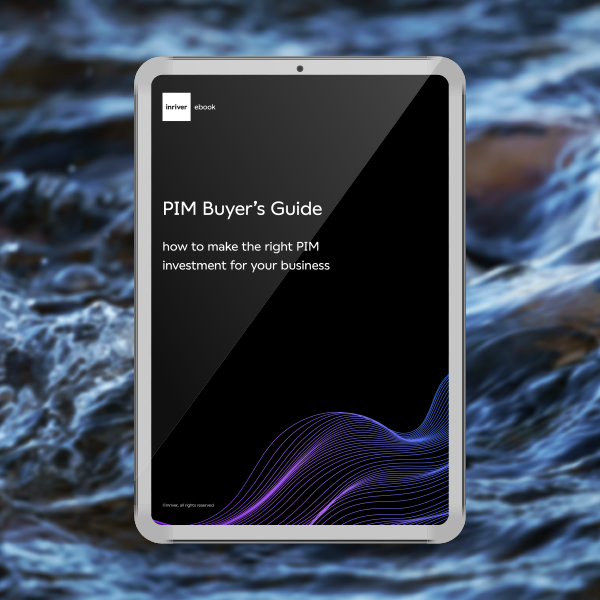PIM for e-commerce
Bring the in-store experience to your digital shelf through better product data management with Inriver, the complete PIMsoftware solution that transforms every aspect of your B2B or B2C e-commerce strategy.
Skip to:
- How does PIM solve today’s biggest e-commerce challenges?
- What is a Product Information Management (PIM) system?
- What are the key benefits and features of PIM for e-commerce?
- How does a PIM system integrate with the rest of your tech stack?
- Key PIM features for e-commerce success
- How to choose the right PIM for your e-commerce business
- What’s the ROI of a PIM system?
- FAQs
E-commerce has evolved from convenience into a competitive necessity. Over the last decade, U.S. e-commerce sales surged by 248%—from $341.7 billion in 2015 to $1.19 trillion in 2024.
Online retail’s share of total retail sales more than doubled, rising from 7.3% to 16.1%. This remarkable growth signals not only rising demand but also increasing complexity for businesses navigating the digital shelf.
As more products flood digital channels, sellers are under increasing pressure to present consistent, compelling product content across every touchpoint.
Whether you’re selling on a global marketplace like Amazon, through regional retailers, or directly to consumers on social platforms like TikTok and Instagram, product data is the foundation of your digital success. Effective e-commerce data management drives conversion and loyalty.
Managing data across all platforms, while maintaining accuracy, speed, and brand integrity, has become one of the biggest challenges in modern commerce. This is where a Product Information Management (PIM) platform comes into play.
But what is PIM? How can it help you meet today’s e-commerce challenges? And how can it take your digital shelf to the next level? Let’s find out.
PIM for E-commerce
PIM software centralizes, enriches, and distributes product content across all digital channels, giving e-commerce brands a foundation for success on the digital shelf.
PIM software ensures every SKU is accurate, complete, and consistent, no matter how fast you scale or how many e-commerce touchpoints you manage.
For e-commerce brands, a modern PIM solution gives teams the control to adapt to new markets, update listings instantly, and power seamless omnichannel experiences.
Key benefits of PIM for E-commerce:
- Centralized product data across all sales and marketing platforms
- Consistent, high-quality content across every channel
- Scalable global content localization
- Scalable operations to support global growth
How does PIM solve today’s biggest e-commerce challenges?
E-commerce teams repeatedly face one challenge: complexity. The faster your product range grows, the harder it becomes to manage. Outdated processes only make it worse. Every new SKU, campaign, or channel introduces more risk of errors and delays.
The challenges are bigger than just messy data or slow launches. Marketplace requirements are multiplying, each with unique rules and content formats. Compliance demands are rising, from sustainability disclosures to product labeling.
Expansion into new markets requires accurate localization, not rushed translations. And if your product content isn’t optimized for search, it’s invisible on the digital shelf.
For e-commerce leaders, these friction points drain resources and stunt growth.
A modern PIM system clears them away, giving every team a single source of truth, automated syndication, and the agility to meet shopper expectations anywhere they buy.
Let’s break down the most pressing challenges and how a PIM solution addresses each one:
1. An increasing number of channels
Gone are the days when a seller could focus on just one marketplace. Today’s digital shelf spans an omnichannel ecosystem—global platforms like Amazon and Temu, niche marketplaces, and social media platforms such as TikTok, Instagram, and Pinterest.
Managing product content across this landscape manually leads to inconsistent messaging, outdated data, and missed opportunities.
How PIM helps: PIM provides a centralized hub to manage, update, and syndicate product content across every channel automatically. It ensures consistency, speeds up channel launches, and reduces manual errors.
2. Growing seller competition
With every new channel comes more competition. Brands and retailers are fighting for visibility and loyalty in every search result, product listing, and feed scroll. To succeed, they need systems that streamline operations and amplify product storytelling.
How PIM helps: A modern PIM system enhances competitiveness by streamlining the creation of rich, accurate product content, enabling sellers to stand out with engaging, SEO-optimized listings and stronger digital shelf presence.
Paired with analytics, it also helps sellers identify which products are underperforming and take corrective action faster.
3. Complex and evolving channel requirements
Retailers and marketplaces continually update their product data requirements—adding new fields, attributes, or formatting expectations. At the same time, shoppers are demanding more transparent information to guide their decisions.
How PIM helps: Advanced PIM solutions enable brands to meet the rising demand for transparent information by facilitating content enrichment and structured data management.
Sellers can tailor product listings for each channel, ensuring compliance with specific requirements while avoiding duplicate work. Automated validations ensure content meets expectations before it goes live.
4. Technological glitches
Syndication failures, out-of-sync inventories, and API breakdowns can stall listings or deliver incorrect data to live storefronts.
How PIM helps: With built-in connectivity tools and error handling, PIM solutions help maintain smooth operations, even when downstream platforms change or experience issues. It acts as a safeguard for your product content pipeline.
5. An expanding customer buying journey
Buyers no longer follow a linear path to purchase. Their discovery process now includes scrolling through influencer content, streaming product reviews, searching across multiple platforms, and shopping at their convenience.
This fragmented path—sometimes described as the “scroll, stream, search, shop” behavior—requires brands to meet customers with relevance at every stage.
How PIM helps: PIM enables brands to deliver contextualized, channel-specific experiences with rich media, accurate specs, and localized content. Whether a shopper encounters a product on a social feed, a comparison site, or a marketplace, the information remains cohesive and compelling. This alignment strengthens brand trust and improves conversion across the entire digital shelf.
What is a Product Information Management (PIM) system?
Imagine walking into a warehouse filled with unlabeled boxes stacked from floor to ceiling. You’re tasked with finding a single item, but with no organization, no system, and no visibility, the job becomes nearly impossible.
That’s precisely what managing product information for ec-ommerce feels like without a PIM system.
A Product Information Management (PIM) system is a centralized platform designed to collect, organize, enrich, and distribute product data across all internal teams and external channels.
It serves as the single source of truth for all information related to your products, including descriptions, images, SKUs, attributes, regulatory information, inventory data, and more.
At its most basic, a PIM gives brands control over how product information is accessed, edited, and shared. However, advanced PIM solutions extend far beyond organization.
They support:
- Data syndication to automate distribution to multiple sales channels
- Digital shelf analytics to track performance and make informed optimizations
- Personalization through localized, channel-ready content
- Omnichannel consistency with real-time updates and validation rules
Whether you’re a B2C retailer juggling seasonal collections or a B2B manufacturer with complex catalogs, a PIM system ensures that every product is always ready for the digital shelf.
Inriver: The complete PIM for e-commerce
What are the key benefits and features of PIM for e-commerce
The digital shelf moves fast. Products are constantly being launched, updated, and personalized for new channels.
How much time do your teams waste chasing product data? How many listings go live late or with errors? How often do returns spike because the content didn’t match the product?
A purpose-built PIM for e-commerce gives you control over these issues. It cleans up your product data, cuts the busywork, and clears the path to scale without adding headcount.
Done right, PIM software fixes today’s problems and provides a strategic foundation for long-term growth.
Here’s how PIM transforms both day-to-day operations and long-term strategy:
1. Organize once, use everywhere
PIM eliminates scattered spreadsheets and disconnected systems by centralizing all product data in one place. This allows internal teams—from marketing to logistics—to access a consistent and trusted source of truth. Fewer errors, faster workflows, and improved collaboration become the norm.
Key features:
- Unified product records and attributes
- Cross-functional access for teams and partners
- Version control and audit tracking
2. Streamline multichannel delivery
Effective multichannel ecommerce strategies require accurate, platform-specific data delivery.
PIM systems automate syndication to marketplaces, retail partners, and social platforms, ensuring content always fits each channel’s structure and standards.
Key features:
- Channel-specific formatting and templates
- Real-time synchronization with external systems
- Built-in validation rules for compliance
3. Power personalized product experiences
Product Experience Management (PXM) is the next evolution of e-commerce. A strong PIM supports PXM by enabling rich, tailored content that resonates with buyers based on channel, region, and intent. From promotional videos to regional specs, personalization becomes scalable.
Key features:
- Localization of product information
- Rich media asset management (images, videos, documents)
- Custom tagging and segmentation
4. Boost agility with performance insights
It’s not enough to publish product data. Sellers need to know what’s working and what’s not. PIM platforms with digital shelf analytics (DSA) provide visibility into content performance, helping brands quickly optimize pricing, availability, and descriptions.
Key features:
- Real-time digital shelf analytics
- Product performance dashboards
- Integration with ERP and analytics tools
5. Support product lifecycle transparency
Modern commerce demands transparency—from sourcing to end-of-life. PIM solutions give businesses the visibility they need to manage sustainability data, compliance information, and circular economy initiatives in one structured environment.
Key features:
- Track material origins and production details
- Document recycling and disposal information
- Enable traceability across supply chain stages
How does a PIM system integrate with the rest of your tech stack?
A PIM system doesn’t operate in a vacuum. For e-commerce operations to run efficiently, product data must connect seamlessly with the systems that power your supply chain, marketing, customer interactions, and web experience. That’s why integration is a core capability for any e-commerce PIM system, not just a nice-to-have.
An advanced PIM system acts as a central hub that harmonizes product information with the rest of your enterprise architecture. Here’s how it fits into the bigger picture:
ERP integration: Align product data with logistics and finance
Connecting your PIM with your Enterprise Resource Planning (ERP) system ensures that product specs, stock levels, and pricing data are always in sync with backend operations.
This enables accurate order processing, inventory tracking, and procurement planning—without relying on manual updates or risky imports.
CRM integration: Enhance customer interactions with smarter product data
When product information is synced with your Customer Relationship Management (CRM) system, sales and service teams have access to richer insights during every interaction.
They can reference specs, upsell related products, and respond to inquiries with accurate, up-to-date data, which improves the buying experience.
CMS integration: Accelerate content delivery across digital channels
Your website and e-commerce storefronts are powered by Content Management Systems (CMS). PIM systems that integrate directly with these platforms make it easier to publish and update product content at scale.
This reduces delays, supports localization, and ensures consistency across digital touchpoints.
Key PIM features for e-commerce success
When choosing the best PIM software for e-commerce operations for your business, start with what matters most: your product data, your speed to market, and your ability to grow.
The best PIM software supports multi-channel publishing, real-time updates, and region-specific content from day one. It’s designed to scale, not stall. Best-in-class PIM platforms offer:
- Centralized data model for all SKUs, regions, and formats
- Built-in channel syndication (marketplaces, D2C, B2B portals)
- Support for digital assets (images, 3D, videos, docs)
- Custom workflows and role-based permissions
- Integration with your existing tech stack
- Localization, translation, and governance tools
- APIs and connectors for omnichannel selling
- Real-time collaboration across teams
- Data quality scoring and enrichment guidance
How to choose the right PIM for your e-commerce business
1. Don’t just buy software, solve problems
PIM software isn’t one-size-fits-all. Before you start comparing features, get clear on what you’re solving.
Ask yourself:
- Are product content errors slowing us down?
- Do we need faster go-to-market cycles?
- Are teams stuck in duplicate spreadsheets?
- Are we entering new markets soon?
- Do we lack visibility into product performance?
The best PIM software aligns with your short- and long-term business goals, not just your current data mess.
2. Ask the right questions before committing
A sleek demo doesn’t mean real-world performance. These questions help cut through the noise:
- Can the data model handle 50K SKUs and custom taxonomies?
- Which integrations are native vs. custom?
- How do teams collaborate inside the platform?
- What does onboarding look like?
- Can we adjust workflows without IT?
Insist on honest answers, not sales fluff. Ask to speak with real customers.
3. Prioritize flexibility over flash
Driven by innovative AI tools, new sales channels, stricter regulations, and evolving buyer behavior, the e-commerce landscape continues to shift rapidly.
Your PIM should be flexible enough to adapt, not lock you into rigid processes or outdated data models.
Look for:
- Open APIs
- Headless-ready architecture
- Plug-and-play integrations with your ERP, CMS, DAM, e-commerce stack
4. Choose a partner, not just a provider
PIM becomes your daily operating system. The vendor should be in it with you.
Look for a partner who:
- Has deep e-commerce expertise
- Understands your vertical or regulatory environment
- Offers strategic guidance, not just technical support
- Invests in product development and roadmap transparency
What’s the ROI of a PIM system?
Implementing a PIM system is a strategic investment with measurable business returns. By centralizing product data and streamlining its management, PIM has a direct impact on speed, accuracy, and revenue growth across the digital shelf.
Accelerated time-to-market
With one system managing all product content, teams can launch new products faster across every channel. Brands using advanced PIM platforms report up to 30% faster product launches, thanks to automation, content reuse, and better internal workflows.
Higher conversion rates
Accurate, enriched product information fosters trust and influences purchasing decisions. By delivering consistent content across all touchpoints—marketplaces, social platforms, and DTC sites—PIM users often see a 20% increase in conversion rates. Rich media, clear specs, and localized data all contribute to stronger engagement.
Reduced product returns
Poor data quality doesn’t just frustrate shoppers—it leads to costly returns. Mismatched specifications, vague descriptions, or missing assets are common causes. With a single source of truth, PIM systems minimize these gaps and can help reduce return rates by up to 40%.
Operational efficiency
When product data is scattered across spreadsheets or siloed in different systems, teams waste valuable time on corrections and manual uploads. PIM reduces this friction through automation and shared access, freeing up teams to focus on optimization instead of troubleshooting.
Ready to see the Inriver PIM in action?
Want to see how Inriver could transform your e-commerce operations?
Let an Inriver expert walk you through how the Inriver PIM could help you turn your product data flows into sustainable revenue flows across all your e-commerce channels.
- Get a personalized, guided demo of the Inriver platform
- Have all your PIM questions answered
- Free consultation, zero commitment
Thanks for reaching out!
We’ll be in touch soon.
Please try again in a moment.


